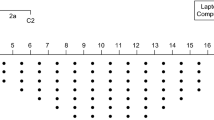Abstract
To improve the global search ability and imaging quality of electrical resistivity imaging(ERI) inversion, a two-stage learning ICPSO algorithm of radial basis function neural network (RBFNN) based on information criterion (IC) and particle swarm optimization (PSO) is presented. In the proposed method, IC is applied to obtain the hidden layer structure by calculating the optimal IC value automatically and PSO algorithm is used to optimize the centers and widths of the radial basis functions in the hidden layer. Meanwhile, impacts of different information criteria to the inversion results are compared, and an implementation of the proposed ICPSO algorithm is given. The optimized neural network has one hidden layer with 261 nodes selected by AKAIKE’s information criterion (AIC) and it is trained on 32 data sets and tested on another 8 synthetic data sets. Two complex synthetic examples are used to verify the feasibility and effectiveness of the proposed method with two learning stages. The results show that the proposed method has better performance and higher imaging quality than three-layer and four-layer back propagation neural networks (BPNNs) and traditional least square(LS) inversion.
Similar content being viewed by others
References
SHIMA H, SAKAYAMA T. Resistivity tomography: An approach to 2-D resistivity inverse problems [J]. SEG Technical Program Expanded Abstracts, 1987: 59–61.
SHIMA H. 2-D and 3-D resistivity image reconstruction using crosshole data [J]. Geophysics, 1992, 57(10): 1270–1281.
LOKE M H, BARKER R D. Least-squares deconvolution of apparent resistivity pseudosections [J]. Geophysics, 1995, 60(6): 1682–1690.
LESUR V, CUER M, STRAUB A. 2-D and 3-D interpretation of electrical tomography measurements, Part 2: The inverse problem [J]. Geophysics, 1999, 64(2): 396–402.
EL-QADY G, USHIJIMA K. Inversion of DC resistivity data using neural networks [J]. Geophysical Prospecting, 2001, 49(4): 417–430.
SRINIVAS Y, RAJ A S, OLIVER D H, MUTHURAJ D, CHANDRASEKAR N. A robust behavior of feed forward back propagation algorithm of artificial neural networks in the application of vertical electrical sounding data inversion [J]. Geoscience Frontiers, 2012, 3(5): 729–736.
SINGH U K, TIWARI R K, SINGH S B. Neural network modeling and prediction of resistivity structures using VES Schlumberger data over a geothermal area [J]. Computers & Geosciences, 2013, 52: 246–257.
NEYAMADPOUR A, TAIB S, WAN A T. Using artificial neural networks to invert 2D DC resistivity imaging data for high resistivity contrast regions: A MATLAB application [J]. Computers & Geosciences, 2009, 35(11): 2268–2274.
SINGH U K, TIWARI R K, SINGH S B. Inversion of 2-D DC resistivity data using rapid optimization and minimal complexity neural network [J]. Nonlinear Processes in Geophysics, 2010, 17(1): 65–76.
NEYAMADPOUR A, ABDULLAH W W, TAIB S. Inversion of quasi-3D DC resistivity imaging data using artificial neural networks [J]. Journal of Earth System Science, 2010, 119(1): 27–40.
NEYAMADPOUR A, ABDULLAH W W, TAIB S, NIAMADPOUR D. 3D inversion of DC data using artificial neural networks [J]. Studia Geophysica et Geodaetica, 2010, 54(3): 465–485.
HO T L. 3-D inversion of borehole-to-surface electrical data using a back-propagation neural network [J]. Journal of Applied Geophysics, 2009, 68(4): 489–499.
CHANDWANI V, AGRAWAL V, NAGAR R. Modeling slump of ready mix concrete using genetic algorithms assisted training of artificial neural networks [J]. Expert Systems with Applications, 2015, 42(2): 885–893.
SAMANTA B, BANDOPADHYAY S. Construction of a radial basis function network using an evolutionary algorithm for grade estimation in a placer gold deposit [J]. Computers & Geosciences, 2009. 35(8): 1592–1602.
KAFTAN I, SALK M, SENOL Y. Evaluation of gravity data by using artificial neural networks case study: Seferihisar geothermal area (Western Turkey) [J]. Journal of Applied Geophysics, 2011, 75(4): 711–718.
CHEN S, COWAN C F N, GRANT P M. Orthogonal least squares learning algorithm for radial basis function networks [J]. IEEE Transactions on Neural Networks, 1991, 2(2): 302–309.
KENNEDY J, EBERHART R. Particle swarm optimization [C]// IEEE International Conference on Neural Networks. Perth, Australia: IEEE Press, 1995: 1942–1948.
TSEKOURAS G E. A simple and effective algorithm for implementing particle swarm optimization in RBF network’s design using input-output fuzzy clustering [J]. Neurocomputing, 2013, 108: 36–44.
LI J, LIU X. Melt index prediction by RBF neural network optimized with an MPSO-SA hybrid algorithm [J]. Neurocomputing, 2011, 74(5): 735–740.
TSEKOURAS G E, TSIMIKAS J. On training RBF neural networks using input–output fuzzy clustering and particle swarm optimization [J]. Fuzzy Sets and Systems, 2013, 221: 65–89.
MENG Y, ZOU J, GAN X, ZHAO L. Research on WNN aerodynamic modeling from flight data based on improved PSO algorithm [J]. Neurocomputing, 2012, 83: 212–221.
SHI Y, EBERHART R. A modified particle swarm optimizer [C]// IEEE International Conference on Evolutionary Computation. Washington DC, US: IEEE Press, 1998: 69–73.
ZHOU P, LI D, WU H, CHENG F. The automatic model selection and variable kernel width for RBF neural networks [J]. Neurocomputing, 2011, 74(17): 3628–3637.
KOKSHENEV I, PADUA B A. An efficient multi-objective learning algorithm for RBF neural network [J]. Neurocomputing, 2010, 73(16): 2799–2808.
BOLBOACA S D, LORENTZ J. Comparison of quantitative structure-activity relationship model performances on carboquinone derivatives [J]. The Scientific World Journal, 2009, 9: 1148–1166.
DAI Qian-wei, JIANG Fei-bo, DONG Li. Nonlinear inversion for electrical resistivity tomography based on chaotic DE-BP algorithm [J]. Journal of Central South University, 2014, 21: 2018–2025.
Author information
Authors and Affiliations
Corresponding author
Additional information
Foundation item: Project(41374118) supported by the National Natural Science Foundation, China; Project(20120162110015) supported by Research Fund for the Doctoral Program of Higher Education, China; Project(2015M580700) supported by the China Postdoctoral Science Foundation, China; Project(2016JJ3086) supported by the Hunan Provincial Natural Science Foundation, China; Project(2015JC3067) supported by the Hunan Provincial Science and Technology Program, China; Project(15B138) supported by the Scientific Research Fund of Hunan Provincial Education Department, China
Rights and permissions
About this article
Cite this article
Jiang, Fb., Dai, Qw. & Dong, L. An ICPSO-RBFNN nonlinear inversion for electrical resistivity imaging. J. Cent. South Univ. 23, 2129–2138 (2016). https://doi.org/10.1007/s11771-016-3269-8
Received:
Accepted:
Published:
Issue Date:
DOI: https://doi.org/10.1007/s11771-016-3269-8



